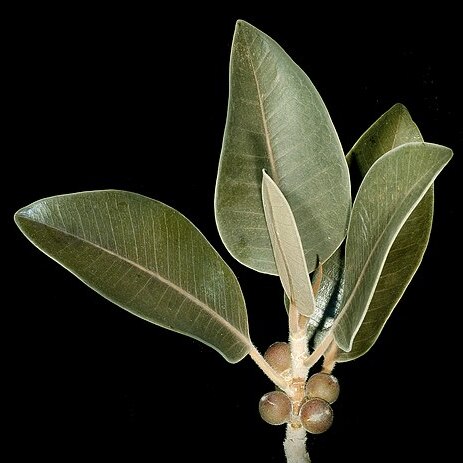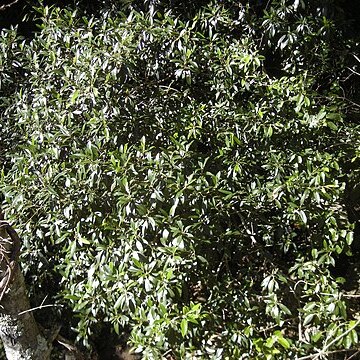Spreading shrub or tree to 6 m high. Leaves alternate; lamina broadly ovate to elliptic, 6–10 cm long, 1–7 cm wide, cuneate, rounded to cordate at base, acute at apex, usually glabrous; lateral veins 10–15 pairs, prominent to indistinct; petiole usually dorsiventrally flattened, 1–4 cm long; stipules small, soon glabrous. Figs globular, 1–1.5 cm diam., glabrous; ostiole often triradiate, slightly umbonate, diam. variable; basal bracts 3, small, soon glabrous; peduncle c. 1 cm long, glabrous to pubescent. Male and female flowers interspersed; tepals 3 or 4. Female flowers sessile. Male flowers shortly pedicellate to subsessile. [The above description of Ficus platypoda from Chew (1989: 45–46) requires revision to include F. leucotricha; also to remove any elements of F. platypoda var. angustata (= F. rubignosa), F. platypoda var. cordata (= F. atricha), F. platypoda var. lachnocaulos and var. minor (= F. brachypoda); for more current treatments see Dixon (2011); Zich et al., Ficus platypoda, in Australian Tropical Rainforest Plants Edn 8 (2020); Ficus platypoda, in FloraBase (accessed 12 January 2022); Ficus platypoda in FloraNT (accessed 12 January 2022) -Editor, 11 January 2022.] Description of F. leucotricha from Chew (1989: 43): Spreading tree to 10 m high, sometimes deciduous; most parts pubescent to velutinous. Leaves alternate; lamina ovate to elliptic, sometimes oblong to pentagonal, 8–13 cm long, 4–9 cm wide, broadly cuneate to rounded, often cordate at base, acute to obtuse, rarely acuminate at apex; lateral veins 10–13 pairs, prominent; petiole 1–2 cm long; stipules 5 cm long. Figs pedunculate or sessile, globular, to 2 cm diam. [1–1.6 cm diam. given in variety descriptions], pubescent to velutinous; ostiole slightly raised, 2 mm diam., often triradiate; basal bracts 2, to 1 cm long and wide [4–6 mm, 8–12 mm, to 10 mm given in variety descriptions], rarely to 1.5 cm; peduncle absent or to 3.5 cm long. Male flowers mainly ostiolar, mixed with female flowers, subsessile; tepals 3. Female flowers subsessile; tepals 4.
More
A fig. It is a small tree. It grows to 6-30 m high. It spreads out and has aerial and clinging roots. The leaves are thick and leathery. They are broadly oval. The blade is 6-10 cm long by 1-7 cm wide. The midrib and veins are distinct. The tip is pointed. The flowers are very small. Both male and female flowers are enclosed in a fleshy receptacle (the fig). The fruit is 0.8-1.4 cm across. It becomes red to purple when ripe. They are commonly in pairs in the axils of leaves.
Lithophytic species mostly restricted to sandstone outcrops but occasionally found on limestone (Dixon 2011: 16); grows in monsoon forest and dry scrub in rocky situations (Zich et al. 2020); sand, alluvium, loam, limestone, sandstone, granite; cliffs, hills, screes, uplands, granite rock pockets (W.A. FloraBase, accessed 12 January 2022).
More
Monsoon forest and dry scrub in rocky situations at elevations up to 300 metres. Sand, alluvium, loam, limestone, sandstone, granite. Cliffs, hills, screes, uplands, granite rock pockets in West Australia.
A subtropical plant. It grows on low rocky coastal cliffs. It is hardy and tolerant to cold. It grows on dry hills. It can grow in arid places. It suits hardiness zones 10-11.



